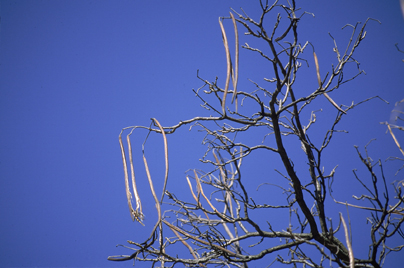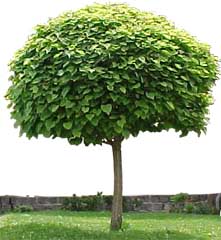 |
| Picture From: The Ohio Department of Natural Resources and The Ohio State University Department of Horticulture and Crop Science, 2002 |
Large
�bean� pods are a distinguishing characteristic of the Catalpa tree.Seeds
can be harvested and used for propagation.Large
crops of pods appear every 2 to 3 years.As
is turns out, this is the most common means of propagation for this tree.

Picture From: The
Ohio Department of Natural Resources and The Ohio State University Department
of Horticulture and Crop Science, 2002
Late winter is the best time to collect seeds.Although, it should be noted that in the fall, the pods will split and release the winged seeds to the ground.Leaving them until after break gives the them time to cure as the Catalpa is dehiscent.Spring time, when the temperature is 70-85 degrees Fahrenheit, is the best time to plant the seeds.Alternatives are using cold frames or greenhouse planting.If all goes well, the seeds should germinate in two weeks.

Catalpa
trees can be propagated from cuttings taken during the summer.Semi-hard
and softwood cuttings can be taken from non-flowering shoots.Studies
have shown that the best cuttings come from first year cuttings.Expected
rooting percentages go from almost 100% for first year, to 77% in third
year [Gardner].
Plants
obtained from other sources may begin in pots.Planting
should occur in the spring or early fall.Keeping
the tree in a sheltered area will help to protect the large leaves from
damage.Again, these trees are tolerant
to dry conditions as well as moist conditions.Pruning
can be kept to a minimum.Training
a younger tree to a straight central leader will help produce the classical
shape and keep weak branches to a minimum.During
the course of its life, a Catalpa will require light pruning of weakened
branches.
Catalpas
can also be propagated by grafting.This
is a recommended procedure if you have a specialty variety and do not want
to risk cross-pollination from related but different varieties.By
grafting, you can also preserve some unique characteristics between varieties.For
example, one resource cites the availability of �Mop Top Trees�.These
trees are smaller trees with topiary like bushy tops.In
the case of a Catalpa �Mop Top�, dwarf Catalpa is grafted onto a seedling
say northern Catalpa.

From: hellohello.com
As
a landscaping plant, the small space requirements and low maintenance make
it a nice alternative to a �true� variety.
| NEXT: Resources
Table of Contents BACK: Introduction Christopher.Besemann@ndsu.nodak.edu March 2003 |